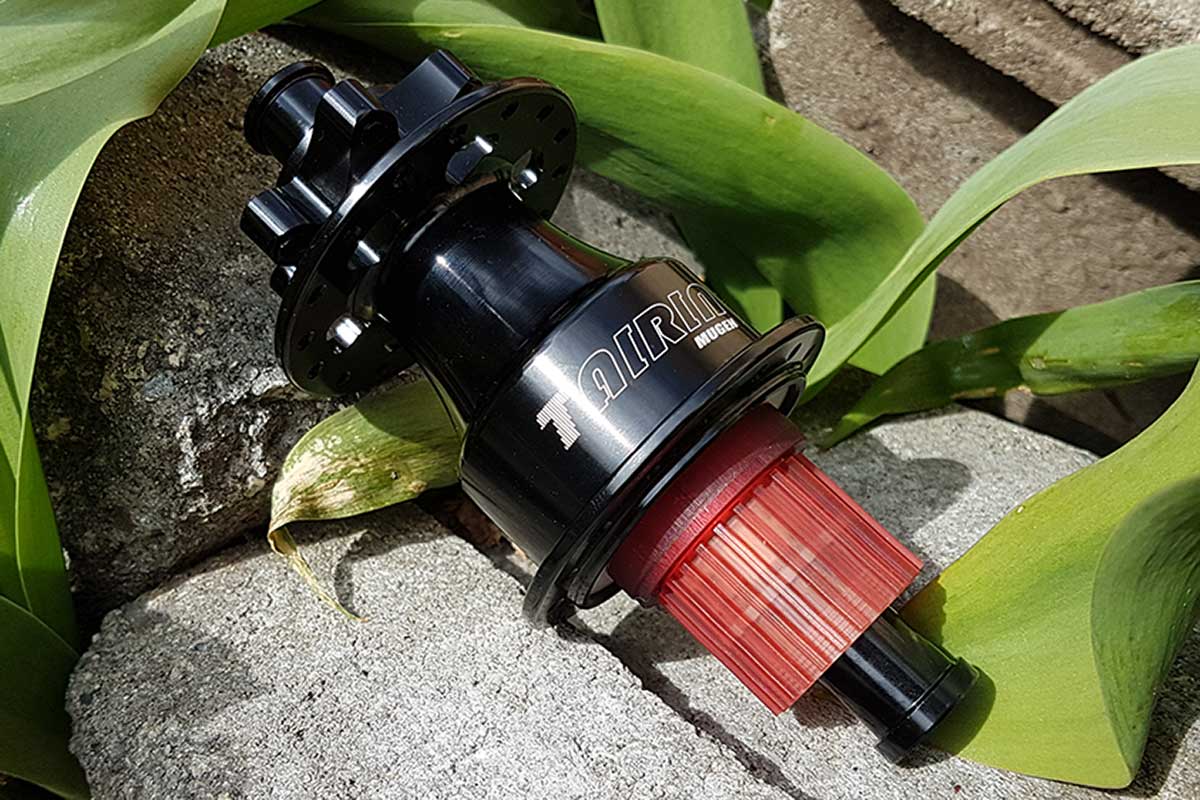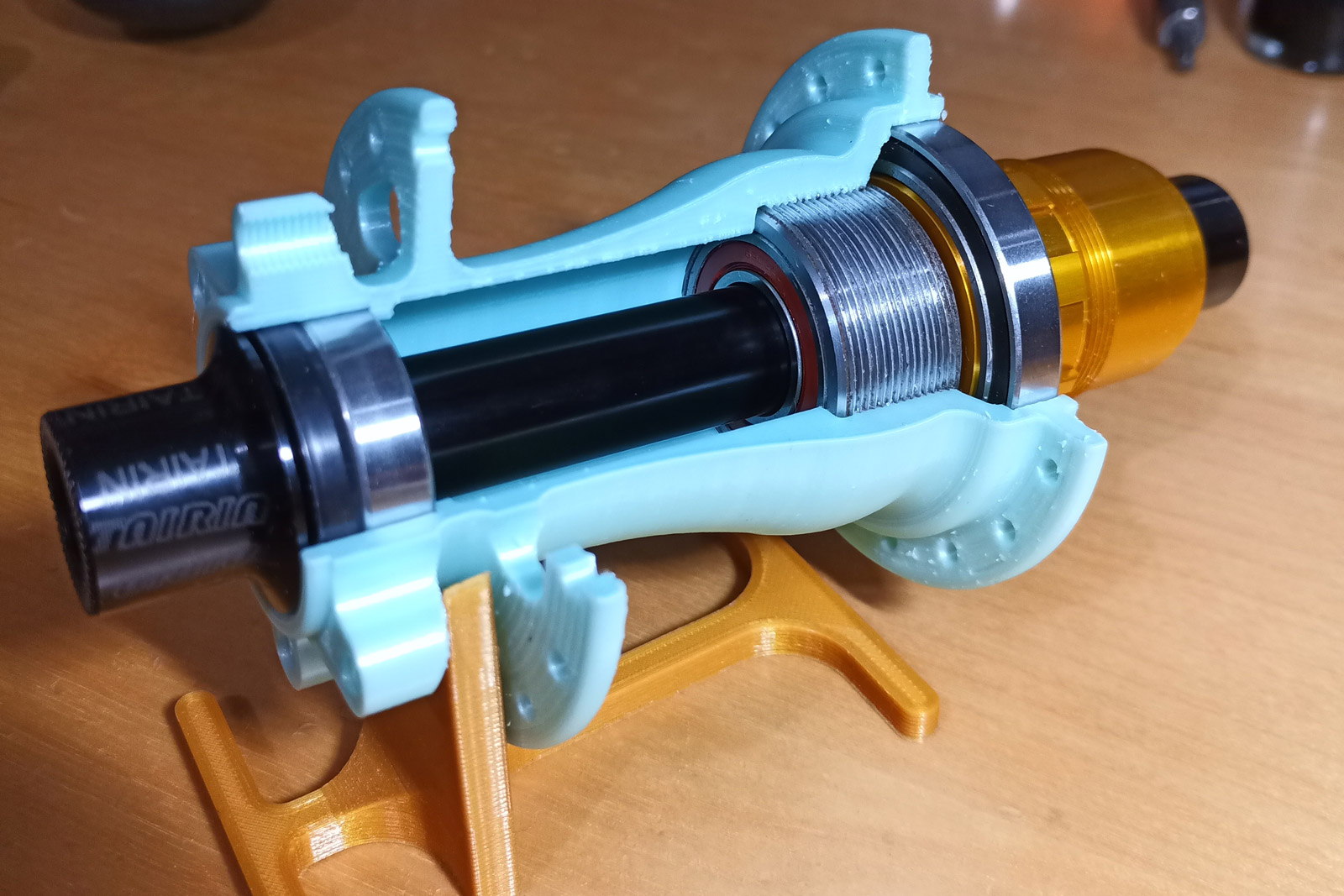Almost two years have passed since we first heard about the Tairin Mugen silent roller clutch drive hub. The BC based wheel company binned the project in 2020 right before release, as their long-term field tests highlighted some deficiencies that could affect the life of the clutch. The hub was very heavy, and the revisions required to improve longevity would add even more weight. Back to the drawing board they went.

Again, the team set out to design a novel mechanism that was simple, easy to service, extremely durable, silent, and one that also addressed pedal kickback that is a feature of most full suspension mountain bike designs. Now, they tell us they’ve done just that, and are preparing to release the new Tairin Silent Star Ratchet Hub in early summer 2022.
The new hub is in fact, modular, with interchangeable parts that allow you to tune the noise generated by the hub, or eliminate it completely. You can run it in Golden Mode which features the silent face gear drive, or Silver Mode, which features a magnetic face gear ratcheting drive with two modes: a quiet ratcheting mode and a loud ratcheting mode. All mechanisms are interchangeable without the use of tools, though the Golden Mode will retail at a higher price than the Silver Modes, which are meant to be more wallet-friendly. Here’s what we know so far about the new Tairin hub.
Tairin Silent Star Ratchet Hub
So, how does this Golden Mode silent star ratcheting mechanism work?

First, a quick overview of how a more familiar star ratchet mechanism works, as seen on DT SWISS hubs. During freewheeling, the star ratchets need to ratchet on every tooth for every ratchet (or every POE). This is what gives rise to the buzzing noise you hear while freewheeling. The noise stops when you start pedaling (at a minimum RPM such that the freehub speed matches the RPM of the wheel), as the spring-backed outboard ratchet engages with its complementary shape inboard counterpart to drive the rear wheel.
It is this mechanism for engagement that sets the new Tairin Silent Hub apart from this more commonly seen star ratchet mechanism employed by DT SWISS and others. On the Tairin hub, during freewheeling, one of the star ratchets (or face gears, as Tairin refer to them) is retracted away from the other. So, there’s no ratcheting, no noise, and also no unnecessary wear on either face gear.
When the rider starts pedaling the mechanism joins the face gears together, continually applying a force to keep them together (again, so long as the freehub speed matches the RPM of the wheel). It is this mechanism that was previously kept under wraps, but since the original publication of this article, Tairin has shared an insightful video on its Instagram account.
It is an initiator mechanism, central to which is a small coil that sits between the freehub body and the outboard face gear. The coil is designed such that, when the freehub rotation matches that of the wheel, the coil guides the outboard face gear inwards to engage with the inboard ratchet, thus driving the wheel. That same coil retracts the outboard face gear during freewheeling.
Tairin tell us that, not only does this novel mechanism give rise to a silent hub, it also improves the freehub’s torque transfer over the lifetime of the hub as the teeth aren’t subjected to wear during freewheeling.
The Floating Engagement Index
Tairin also claim their new silent hub can reduce the pedal kickback experienced on some full suspension bikes. If you’re not sure what that is, you can check out Tyler’s short video explainer here. Basically, as a full suspension bike is pushed through its rear wheel travel, depending on how fast the rear wheel is spinning, and how fast the compression event is, the bike can suffer from chain growth. The cranks are forced to rotate rearward to deliver the additional chain required in that scenario, and it can be an unsettling feeling for the rider.
On any hub, of the star ratchet or pawl design, there is scope for pedal kickback. Really, it’s not something that happens to any noticeable degree in most riding scenarios, but it is true that a higher number of engagement points can result in more pedal feedback overall than a hub with fewer POEs. That’s because a higher number of engagement points means that fewer degrees of rotation are required at the cranks in order to engage the freehub.
The Tairin hub does not eliminate pedal kickback, of course. The engagement is set to 7°, so some bikes will still exhibit it to some degree in certain riding scenarios. What the Tairin hub does do, is make it more consistent thanks to the Floating Engagement Index.
Jose Hsu, the Mechanical Design Engineer at Tairin Wheels explains, “We were also able to manipulate the speed of the engagement, and introduce the concept of a floating engagement index start point. This just means that, if we settled with a 7 degree freehub rotation to engage the hub, one must match the freehub rotation with wheel rotation (RPM) speed plus 7 degrees of freehub rotation to engage in torque transfer (or 7 degrees of crank rotation if you were on a 1:1 ratio drivetrain). The moment you freewheel again, the engagement index is reset back to 0 degrees”.
“This is unlike indexed standard ratcheting systems, where you are momentarily engaged right after every ratcheting click. A ratcheting 10 degree clutch freewheeling would go from engaged to 10 degrees from engagement in 36 cycles every revolution (36 Points Of Engagement). Our floating index start point is always at 0 degrees when freewheeling”.
Jose also revealed that the new hub will run a token-based pre-load system at the end caps.
The Tairin Silver Modes
The Silver Modes of the new Tairin hub are mechanistically different to the Silent Hub. It all runs of the same hub shell of course, but the Silver Modes lack the initiator mechanism seen on the Silent Hub that allows retraction of the outboard gear face during freewheeling.
In the Silver Mode, the face gears ratchet against one another as they do in traditional star ratchet hubs, resulting in a buzz noise. The noise is tuneable, however. In this system, in place of a spring, there is a magnet that pushes the face gears together for engagement. A strong magnet gives rise to a loud noise, while a weaker magnet makes for a quieter, but still plenty audible, freehub noise. These are said to be easily interchangeable without the need for tools.
Pricing & Availability
The new Tairin Silent Hub and its more affordable (but noisy) Silver Mode magnetic ratcheting counterparts will be available with Shimano Microspline, Shimano HG and SRAM XD freehubs, in the following specs:
- 12mm x 148mm Boost, 32 and 28 holes
- 12mm x 142mm, Non-Boost 32 and 28 holes
- 10mm x 135mm, 32 and 28 holes with the E-Thru system
- 10mm x 141mm Boost, 32 and 28 holes (for open dropout) with the E-Thru system
- 12mm x 157mm Superboost, 32 and 28 holes
- Single Speed 10mm x 135mm, 32 and 28 holes with a short HG drive and the E-Thru
As with all Tairin hubs, the Booster (142->148) and Superbooster (148->157) adaptive kits can be applied to the new Tairin Silent Hub.
No word on pricing yet, but expect these to become available by early summer.


